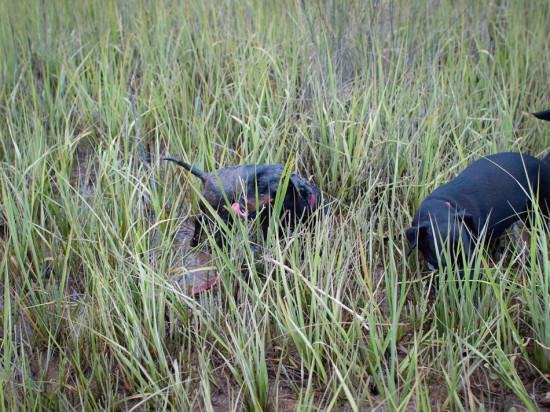Wiener dogs bodies are not good regulators of heat.
Tag Archives: Georgia
Sea oxeye
Also known as sea oxeye, Borrichia frutescens is a perrenial sunflower that grows at Skidaway Island State Park and blooms throughout most of June. It grows in abundance adjacent to channels within the salt marsh.
Eastern oyster with imposter
Gators and all
A brisk walk at Harris Neck National Wildlife Refuge with the dogs last November. We encountered a small alligator, but the dogs didn’t notice…
Cooled and ready
Excited to move on
Rollin’ in the mud
No big changes: Castro is still wrong, a single workout doesn’t predict things well, and 300 is a magic number
Here’s a summary post for my series on predicting regional qualification from single-workout performance during the CrossFit Games Open.
I’ve again copied the leaderboard data from the Games website for the top 180 women in the five regions indicated in my first post (additionally, I’ve added a sixth region with the dataset used in these analyses, the South Central region, only because I couldn’t remember if I took SoCal or S. Central last time).
“You should not go to Regionals, you should not go to Regionals if you don’t have a basic move like the muscle-up. Period.” – Dave Castro
No, Dave Castro, you do not need to have a muscle-up to qualify for Regionals… although it would help.
The results of 2014’s CrossFit Games Open were similar to past years in that there was a high range in overall score in the top 48 in each region, and there were atheletes that qualified for Regionals that did not complete a muscle-up in 14.4.
The overall score ranged from 16 to 516 total points for women qualifying for Regionals – this is consistent with previous years, and my estimate that 500 total points would be about the cut-off for Regional qualification (Fig. 1).
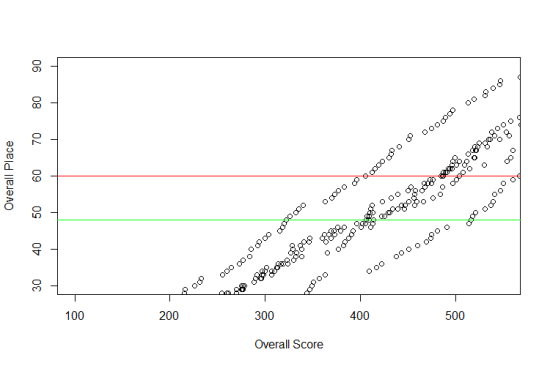
In the leaderboard data I analyzed, four women qualified for Regionals that did not complete a muscle-up in 14.4, but each did achieve a score of 180 on that work out, meaning they completed all the Power Cleans, and probably had some time to attempt a muscle-up. These women did place relatively high in the overall regional placement (each placed 39, 46, 47 and 48), but they still qualified.
And, this is exactly what we’ve seen in the past; the Open workouts are broad enough that a single movement will not necessarily disqualify an athlete.
Five workouts still serve a purpose
Somewhat mundanely, 2014’s Open competition supports my original conclusion: predicting regional qualification from a single workout’s performance is useless.
Figure 2 is similar to Figure 2 in a previous post, but includes only leaderboard data from 2014. Again, the r-squared of the regression (red line) is low (0.33), suggesting that a single workout score is little indication of how an athlete with place in the end and, therefore, whether or not she will qualify for Regionals.
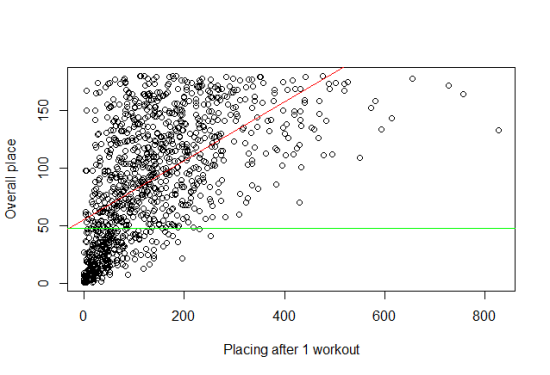
Let’s magnify again:
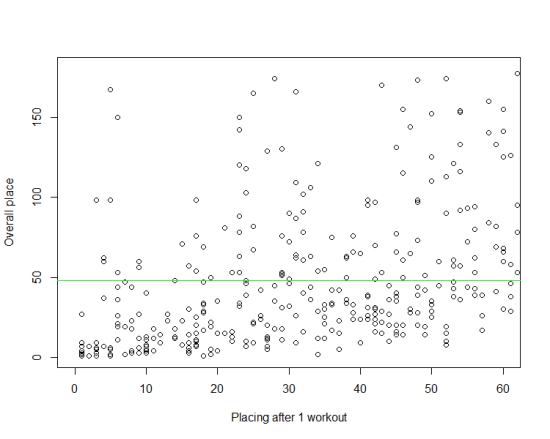
Now, think about it this way: An athlete places in the top 60 on an Open workout (or even in the top 10)… will she qualify for Regionals? Figure 3 says: who knows!? There are plenty of points above the green line in this plot, which represent athletes who finished in the top 60 in at least one workout, but didn’t make it to Regionals.
Let’s wrap it up
From a predictability standpoint, the 2014 CrossFit Games Open wasn’t that different from 2012 or 2013. Not even muscle-ups were as hard a line as Castro predicted.
The range of overall scores were similar: a total point score of ~500 was the cut-off in all three years.
The maximum placing was similar; I predicted getting over 300th place in any one workout will doom a competitor from qualifying for Regionals, and guess what the maximum place for a Regional qualifier was: 322 achieved by Hanna Gartman of CrossFit Hardcore North finishing 47th in the South East. Behind her was Becky Conzelman of Backcountry CrossFit, having a maximum placing of 294, but finishing 47th in the South West region. Importantly, Becky’s profile reports that she’s 42 years-old. Of regional qualifiers, she had the second worst performance across six regions in a single workout, but she still rocked it hard enough to qualify… at the individual women’s level, not just masters’ level. Awesome.
And the regional qualifier with the third worst performance in any single 2014 Open workout was… Allison Brager, of CrossFit Terminus, finishing 44th in the South East with a maximum placing of 273. So perhaps her worry of qualifying for Regionals as an individual was justified…
Update 4: Predicting regional competitors from single Open results
Original post
Update 1
Update 2
Update 3
In previous posts, I’ve presented on the range of Open workout placings athletes have and its impact on CrossFit Games Regional qualification. Here, I’ve produced some simple, linear regressions that try to predict overall place during an Open competition from knowledge of one to four individual workout placings.
The Question
A question one might ask is: I am currently ranked at 100th overall after 14.1 and 14.2, how well does this placing predict my ranking by the end of the Open competition?
Short answer: It doesn’t.
Long answer: Not very well. Let’s demonstrate what I mean with another set of plots.
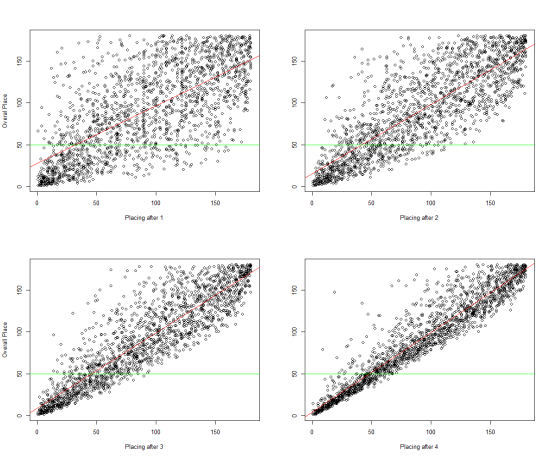
Click on the image to make it bigger. Figure 1 shows four regressions performed after plotting an individual’s overall placing after 1, 2, 3, or 4 Open workouts against her finishing, overall place.
Let’s look at the top left plot. An athlete performs the first workout of the year, and she scores 100th. This plot says: there is no way we can accurately predict how she will finish. While the regression is statistically significant, the r-squared is 0.48, which isn’t very high. Just look at all the variation!
Now take a look at the top-right plot. After two workouts, the data tighten (this is partially an artifact of how I produced these data) and are better predicted by the red regression, but there is still a huge amount of variation that doesn’t fall directly on that red line. If all the points fall on that line, it suggest that we can easily predict overall place from placings after a given number of workouts. The r-squared is increased to 0.67, but someone ranked 100th after two workouts still has a good chance at qualifying for Regionals – that is, there are still a good number of points falling below the green line where x = 100.
Notice that the data get closer to the red line (the regression) as more workouts are added. Makes sense: if you’re ranked 100th after four workouts, it’s pretty unlikely that the 5th workout will swing you up or down too much in the overall rankings. But it does happen.
I generated the mid-Open rankings (overall placings after 1, 2, 3, and 4 workouts) with the sample() function in R, which gives me some ‘randomness’. For instance, sample() was used to randomly select two workout-specific placings of the total five for a given athlete and given Open competition. Thus, ‘Placing after 2 workouts’ is not an athletes actual placing after 12.1 and 12.2, it’s a placing I calculated after drawing, at random, 2 of the 5 workouts for that athlete in 2012, and them ranking them with another R function (rank()). A problem with this approach: maximum rankings are capped at 180 for all the plots, but an athlete could have been ranked much higher in the actual Open. Figure 2 is an example where the actual workout placings are considered and used to predict overall placing. This is the same data as the top-left plot in Figure 1, but I haven’t ranked it myself. The data don’t even appear to be linear (the data look to be curving upwards), and the r-squared of the regression has fallen to 0.38. I can’t do this with the other three plots without copying the data from the Games webpage again.
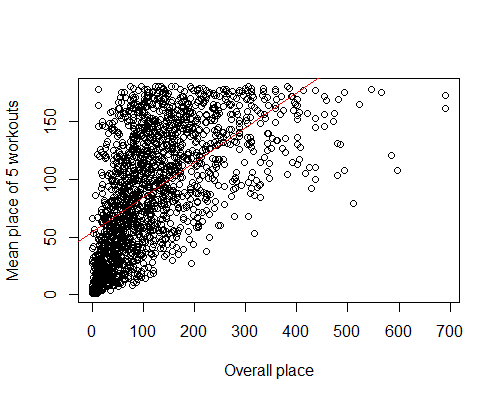
There are other weird artifacts that I’ve introduced with these data, but I think the problems cause my results and conclusions to be conservative. That is, if I had all the data, there would be more variation and unpredictability… If you’re interested in knowing how, comment or ask.
Bigger picture
This post presents more evidence that watching rankings closely early in an Open competition is of little value. Sure, it’s not going to be easy or likely that one will qualify for Regionals after hitting >300th place in a single workout, and it will be harder if you’re ranked 150th after three workouts… but it’s been done before. This is, again, a reason to stay positive, and to strive to be better.
Update 3: Predicting regional competitors from single Open results
Here’s another contribution to my analyses of the CrossFit Open competition, and is continued from here, where I looked broadly at maximum and minimum placings among Open competitors, and here, where I examined the frequency that athletes finished within the top 60 of a given Open workout and how that related to qualification for Regionals.
This particular post is an extention of my brief analysis examining probabilities of Regional qualification with top 50 finishes during the Open.
Remember
This post attempts to address (2): your chances of qualifying for Regionals with a particularly high Open placing.
I’m going to refer to “maximum placing” again, which seemed to cause some confusion in my past posts. Maximum is highest absolute value. For instance, 398th is a higher place than 2nd place. So, “maximum” is “bad” if you’re interested in competing.
I’ve got plots to present, and I will summarize them in the last paragraph of this post.
Past probabilities of qualifying based on maximum and minimum placings
So you’re interested in qualifying for Regionals, but 14.3 is a culmination of all of your weaknesses: triple-under, backflip, muscle-ups, while holding a perfect D-flat major. You compete, and finish as expected, but not to your liking. Do you still have a chance at qualifying?
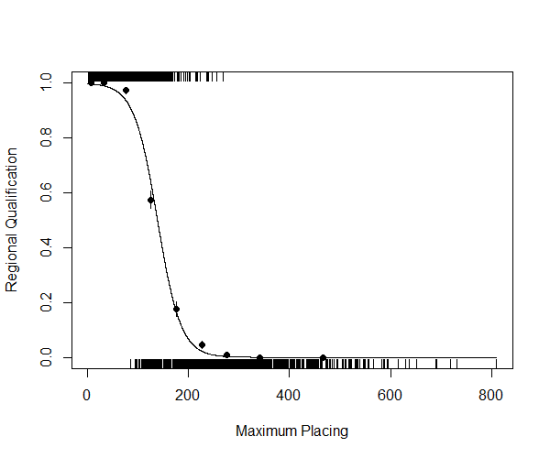
Figure 1 is similar to what I presented in my previous post, but the x-axis has been replaced with Maximum Placing – the highest place value (remember, high is ‘bad’) an athlete received during a given Open competition.
Each little, vertical line represents one athlete, during one Open competition (1800 total), and it is placed on the bottom (y = 0) for non-regional qualifiers, and on the top (y = 1) for the Regional qualifiers. Where each line along the x-axis represents her maximum placing of the five workouts in a given Open.
Again, the curved line is what is interesting; more specifically, the rapid change illustrated by the curve. The line lets us estimate the chances of an individual qualifying for regionals, given a particular place in an Open workout – in this case, it’s the maximum place scored. As you move from a low maximum (<50th) to about 300th place, qualifying athletes drop dramatically. Let’s zoom in:
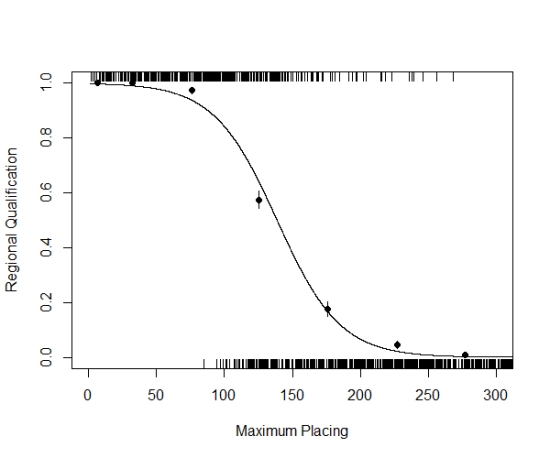
If we again follow the closed circles, which represent empirical probabilities that an athlete will qualify, athletes with a maximum placing below 50, have a 100% chance of qualifying, but those chances start dropping off quickly:
- 97% with maximums below 100th
- 57% with maximums below 150th
- 18% with maximums below 200th,
- 4% with maximums below 250th, and
- 0.09 % by the time we reach a maximum of 300th place.
Summary
This is exactly what I found in my first post – get a score above 300th place and you’ll be breaking records if you qualify for Regionals. It’s very unlikely that you have a shot at that point…. But, I need to emphasize the limits of my dataset. These ‘probabilities’ are not actually probabilities (more accurately, they are estimates of the contribution of maximum placing to regional qualification taken from fitted models to past data), and they only apply if you happen to be a women, in one of the five regions listed in the first post… during Open years 2012 and 2013.
So, take these data with a grain of salt. In fact, take them only as encouragement, and a push to do better next time. The data simply show what has occurred in past Open competition (there have only been two), and one of the mantras of CrossFit is to always push harder and surprise yourself. If you finish 301st in 14.2, make me recalculate my estimates and make new plots. (is that motivating to anyone?)
















